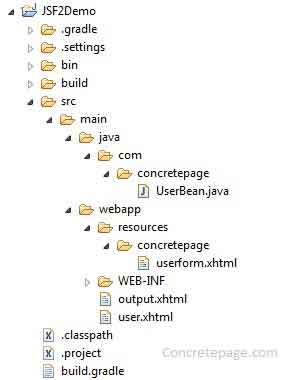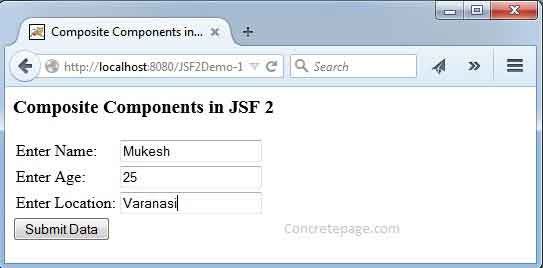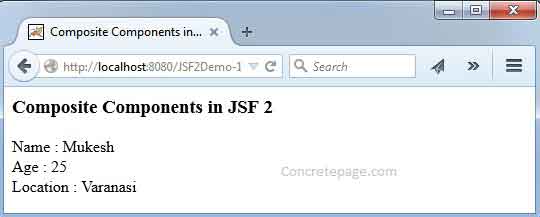JSF 2 Composite Components Example | Create Custom Tag
January 23, 2015
In this page we will learn creating composite component in JSF 2 with the help of composite:interface, composite:attribute and composite:implementation tag. JSF 2 allows to create template which can be reused where ever we want. To do it, create a directory named as resources parallel to WEB-INF. Inside resources directory, create a folder as we want and then create template file . The name of our template file will be our custom tag name.
Project Structure in Eclipse

Create Template with Composite Interface and Implementation
We will create a template with the help of composite:interface, composite:attribute and composite:implementation. Perform some basic task.1. Create a directory named as resources parallel to WEB-INF
2. Create your own directory and inside it create your own file and import xmlns:composite="http://java.sun.com/jsf/composite
For the example, if we create template file as Resources/concretepage/ userform.xhtml then to use it, we will import it any JSF file as
xmlns:concretepage = "http://java.sun.com/jsf/composite/concretepage"
Here our own tag is concretepage and can be used in any JSF file as <concretepage />. We can define its attribute using tag composite:interface which defines the name of tag attribute using sub tag composite:attribute . Now create the template using composite:implementation tag. Find the template file.
userform.xhtml
<html lang="en"
xmlns="http://www.w3.org/1999/xhtml"
xmlns:h="http://java.sun.com/jsf/html"
xmlns:f="http://java.sun.com/jsf/core"
xmlns:composite="http://java.sun.com/jsf/composite">
<h:body>
<composite:interface>
<composite:attribute name="nameLabel"/>
<composite:attribute name="nameValue"/>
<composite:attribute name="ageLabel"/>
<composite:attribute name="ageValue"/>
<composite:attribute name="locationLabel"/>
<composite:attribute name="locationValue"/>
<composite:attribute name="submitButtonLabel"/>
<composite:attribute name="submitButtonAction" method-signature="java.lang.String save()" />
</composite:interface>
<composite:implementation>
<h:panelGrid columns="2" id="userPanel">
#{cc.attrs.nameLabel}:
<h:inputText value="#{cc.attrs.nameValue}"/>
#{cc.attrs.ageLabel}:
<h:inputText value="#{cc.attrs.ageValue}"/>
#{cc.attrs.locationLabel}:
<h:inputText value="#{cc.attrs.locationValue}"/>
</h:panelGrid>
<h:commandButton value="#{cc.attrs.submitButtonLabel}" action="#{cc.attrs.submitButtonAction}"/>
</composite:implementation>
</h:body>
</html>
Use Template
To use our template, we need to import asxmlns:concretepage = "http://java.sun.com/jsf/composite/concretepage"
Now we have a new tag which has the attribute defined in userform.xhtml.
user.xhtml
<html lang="en"
xmlns="http://www.w3.org/1999/xhtml"
xmlns:h="http://java.sun.com/jsf/html"
xmlns:f="http://java.sun.com/jsf/core"
xmlns:concretepage = "http://java.sun.com/jsf/composite/concretepage">
<h:head>
<title>Composite Components in JSF 2</title>
</h:head>
<h:body>
<h3>Composite Components in JSF 2</h3>
<h:form id="userForm">
<concretepage:userform
nameLabel ="Enter Name"
nameValue ="#{userBean.name}"
ageLabel ="Enter Age"
ageValue ="#{userBean.age}"
locationLabel ="Enter Location"
locationValue ="#{userBean.location}"
submitButtonLabel ="Submit Data"
submitButtonAction ="#{userBean.save}" />
</h:form>
</h:body>
</html>
output.xhtml
<html lang="en"
xmlns="http://www.w3.org/1999/xhtml"
xmlns:h="http://java.sun.com/jsf/html"
xmlns:f="http://java.sun.com/jsf/core">
<h:head>
<title>Composite Components in JSF 2</title>
</h:head>
<h:body>
<h3>Composite Components in JSF 2</h3>
Name : #{userBean.name} <br/>
Age : #{userBean.age} <br/>
Location : #{userBean.location} <br/>
</h:body>
</html>
Managed Bean
Find the managed bean used in the example.UserBean.java
package com.concretepage;
import javax.faces.bean.ManagedBean;
import javax.faces.bean.RequestScoped;
@ManagedBean(name = "userBean", eager = true)
@RequestScoped
public class UserBean {
private String name;
private Integer age;
private String location;
public String save(){
System.out.println("Inside save");
return "output";
}
public String getName() {
return name;
}
public void setName(String name) {
this.name = name;
}
public Integer getAge() {
return age;
}
public void setAge(Integer age) {
this.age = age;
}
public String getLocation() {
return location;
}
public void setLocation(String location) {
this.location = location;
}
}
Output
To check the output, access the URLhttp://localhost:8080/JSF2Demo-1/user.xhtml. We will find the page as below.




